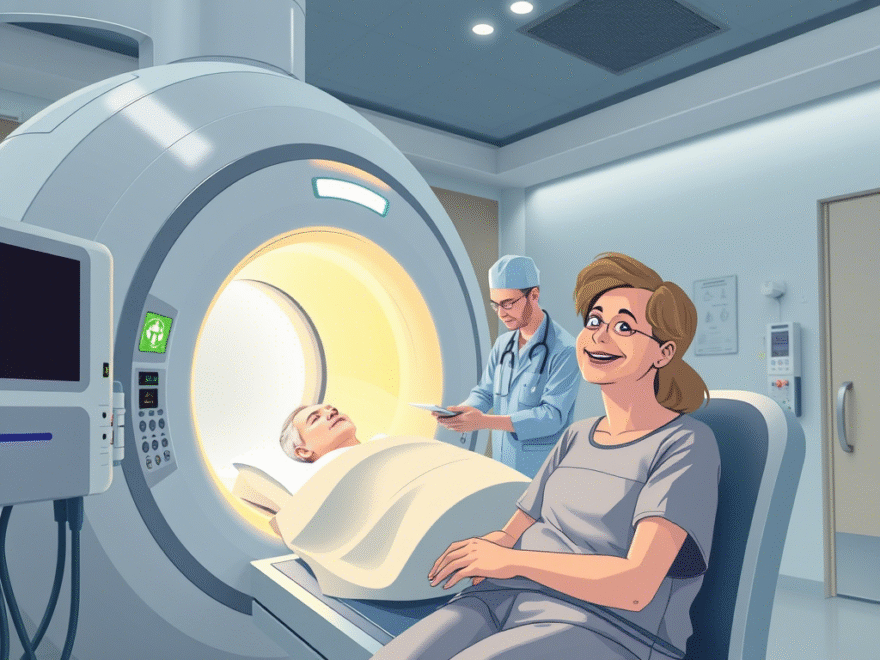Proton Therapy Shows Promise in Fighting Rare Cancers
A new proton therapy approach is emerging as a powerful tool against aggressive cancers, with minimal side effects. In a recent case involving a rare tumor of the salivary gland, this highly precise form of radiation successfully destroyed the cancer without damaging surrounding healthy tissue.
This breakthrough highlights the potential of proton therapy to transform treatment for hard-to-target cancers, offering hope for safer and more effective outcomes.
A new radiation therapy technique is proving highly effective against hard-to-treat cancers — with minimal side effects. Unlike traditional radiation, which can cause serious complications, this advanced method has shown promising results in targeting aggressive tumors while keeping damage to a minimum.
The only reported side effect in one case was slight skin discoloration, and even that remained mild nine months after treatment.
The approach, called step-and-shoot proton arc therapy , was first used by doctors at Corewell Health William Beaumont University Hospital in Michigan. It marks a significant step forward in the precision delivery of cancer care.
A New Era in Precision Cancer Therapy
For the first time, doctors at Corewell Health William Beaumont University Hospital in Michigan have used a cutting-edge proton therapy technique called step-and-shoot proton arc therapy to treat a cancer patient.
This advanced method delivers radiation with exceptional precision, targeting tumors more effectively while minimizing damage to surrounding healthy tissues. Unlike traditional approaches, the system uses a continuous proton beam that moves in arcs around the patient, delivering focused doses at key points.
Fully automated, the process reduces delays between radiation bursts, improving both accuracy and treatment efficiency.
Unlike older techniques that rely on manual adjustments and may be slower and less precise, this new proton therapy allows doctors to target tumors with remarkable accuracy. Early results indicate it effectively spares surrounding healthy tissue and organs, leading to fewer side effects — a major benefit for patients.
This advancement proved crucial for Tiffiney Beard, a 46-year-old from Redford, Michigan, who underwent the treatment after being diagnosed in early 2024 with adenoid cystic carcinoma — a rare and aggressive form of salivary gland cancer known for spreading along nerves.
“Treating this type of tumor is especially challenging because it tends to follow nerve pathways,” explained Dr. Rohan Deraniyagala, a radiation oncologist at Corewell Health.
Avoiding the Downsides of Traditional Radiation
Dr. Deraniyagala explained that because these types of tumors tend to grow along nerves, treating them often leads to side effects such as fatigue, jaw pain, difficulty eating or swallowing, loss of taste, headaches, and memory problems. In Beard’s case, the tumor had spread into the nerves connected to her brain, making it even more challenging to treat.
However, thanks to this new therapy, she experienced no side effects during or after treatment. The procedure itself was also time-efficient — lasting about 30 minutes a day, five days a week for three months — allowing her to continue working and spending time with her family without major disruption.
No Cancer Detected After Treatment
Beard finished her treatment in early August last year, and during her most recent follow-up, there were still no signs of cancer. According to Dr. Deraniyagala, she has shown no signs of radiation damage to other parts of her body, including her brain.
“It’s rare to see a patient go through radiation with no side effects at all,” he said. “The only change was slight skin discoloration on the left side of her face — nothing more.”
A Promising Future for Proton Therapy
While treatment results can vary from patient to patient, Dr. Deraniyagala remains optimistic that others may experience outcomes similar to Tiffiney Beard’s. “Proton therapy is advancing quickly,” he said. “In Tiffiney’s case, step-and-shoot proton arc therapy has already shown great promise — but it’s just one step toward even better treatments on the horizon.”
He added, “The fact that she had almost no side effects is not only a success for her, but also a strong indicator of how far this technology has come — and where it’s heading.”
At Corewell Health’s William Beaumont University Proton Therapy Center, doctors and researchers are now testing an even more advanced system called DynamicARC® — a next-generation proton therapy with the potential to revolutionize cancer treatment further.
Developed in collaboration with Ion Beam Applications (IBA), a global leader in proton therapy systems, DynamicARC® aims to improve upon the current step-and-shoot technique by eliminating delays between radiation doses and beam angles, allowing for even more precise and efficient treatment.
The new system is expected to receive FDA approval in 2025 .
